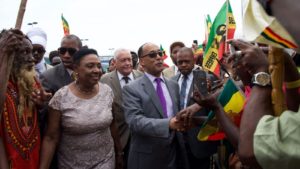By Rebecah Kebede

Prince Ermias Sahle Selassie, welcomed to Jamaica 50 years after his grandfather Emperor Haile Selassie. (Rebekah Kebede)
Kingston, Jamaica, It was a rainy April day in 1966 when Emperor Haile Selassie came to Jamaica. As his plane landed, the rain stopped, and the tarmac was mobbed with people. The crowd shoved security forces out of the way, and official protocol had to be scrapped. Inside the plane, the Emperor waited for half an hour, surprised and overwhelmed by the enthusiastic welcome.
That visit 50 years ago is the stuff of legend, retold again and again. For Rastafarians, it was a visit from a man they consider divine. For newly independent Jamaica it was the visit of an African king.
I arrived at the same airport on Apr. 21, 50 years to the day since the Emperor’s visit, and the atmosphere was electric. Hundreds of Rastafarians arrived in buses, many dressed in traditional Ethiopian embroidered garb. They held signs in Amharic, an Ethiopian language, welcoming the grandson of Haile Selassie, their messiah, back to Jamaica. The air was thick with the smoke of ganja, which Rastafarians smoke as a sacrament. As the crowd chanted, a drum circle beat out a sacred rhythm.

A Rastafarian guard of honor.(Rebekah Kebede)
April 21, is “Grounation Day” for Rastafari (as Rastafarians refer to themselves), a holy day that marks their messiah’s setting foot on Jamaican ground. At the airport on this day, people carried framed photographs of the Emperor in a military cap. One man wore the same cap in the rasta colors with the Emperor’s visage knitted into it.
Yet the prince who approached the crowd outside Kingston airport had close cropped hair and wore a conservative grey suit.
Two lines of men in bright red, dreadlocks piled high on their heads or flowing down their backs, held up Ethiopian imperial flags—green, gold, and red with the Lion of Judah in the center—forming an arch for him to walk through.
It was a scene that could be hardly be more different from the formality of the Ethiopian royal family. Rastafarianism, a strongly anti-establishment religion that condemns the material world of “Babylon,” and the Ethiopian royal family, perhaps the very definition of the establishment, are strange bedfellows.
And yet, as the prince passed and the crowd stretched out to touch him, the prince reached back, grasping their hands.
The Black king to the East
How did a monarchy in East Africa, thousands of miles away from Jamaica, form a bond with an anti-establishment movement on an island in the Caribbean? Why was a prince whose family was overthrown over forty years ago greeted with ululation and celebration?
The answer turned out to be in a phrase of Marcus Garvey’s, the Jamaican black nationalist, that was repeated over and over as I followed Prince Ermias around Kingston during his four-day visit: “Look to the East for the crowning of a Black King, he is the Redeemer for the days of deliverance are near.”
Source: Quartz


